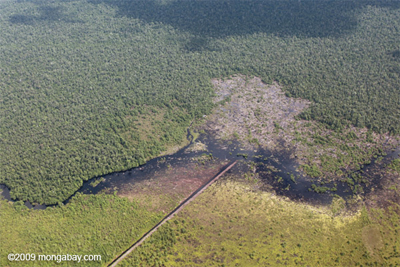Greenhouse gas emissions from deforestation are lower than previously believed, according to a new study published in Nature Geoscience. The findings mean that developing countries may see less money under Reducing Emissions from Deforestation and Degradation, a proposed climate change mitigation mechanism.
The Intergovernmental Panel on Climate Change (IPCC), using 1980s and 1990s-era forest surveys and satellite data, previously estimated emissions from deforestation and forest degradation at around 17 percent of total anthropogenic carbon dioxide. The new study, based on updated forest cover data and accounting for significantly increased fossil fuel emissions, puts the figure at 12 percent, a 23 percent reduction, although the authors, led by Guido van der Werf of Vrije Universiteit in Amsterdam, note that the percentage is highly variable on a year-to-year basis.
|
|
The apparent decline in deforestation’s contribution to global CO2 emissions is tempered when the authors include emissions from peatlands degradation. Drainage and burning of peatlands — wetlands that store massive amounts of carbon — released an average of 300 million tons of carbon per year between 1997 and 2006, or roughly 3 percent of annual emissions. Thus emissions from degradation of destruction of forests and peatlands amount to around 15 percent of CO2 released by human-caused activities.
While the findings show that “reducing fossil fuel emissions remains the key element for stabilizing atmospheric CO2 concentrations,” the authors say protecting carbon-rich ecosystems remains essential to any effort to limit climate change.
“Efforts to mitigate emissions from tropical forests and peatlands, and maintain existing terrestrial carbon stocks,remain critical for the negotiation of a post-Kyoto agreement,” they write. “Even our revised estimates represent substantial emissions, and for about 30 developing countries, including Brazil, Bolivia, Indonesia, Myanmar and Zambia, deforestation and forest degradation are the largest source of CO2. Moreover, reductions in the emissions from deforestation and degradation of peat and forest may remain one of the more cost-effective ‘wedges’ that can help to stabilize atmospheric CO2 levels.”
The authors conclude by urging “a strong focus on monitoring changes in carbon content” in a post-Kyoto agreement to ensure the effectiveness of REDD programs. They note that satellite-based remote sensing can help track emissions from deforestation and degradation of peatlands and forests.
G. R. van der Werf, D. C. Morton, R. S. DeFries, J. G. J. Olivier, P. S. Kasibhatla, R. B. Jackson, G. J. Collatz and J. T. Randerson. CO2 emissions from forest loss. Nature Geoscience | VOL 2 | NOVEMBER 2009.

